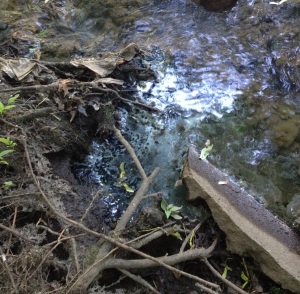On a Saturday in June, an anonymous citizen watchdog alerted Save the Sound to a sewage overflow entering the Hutchinson River from Mount Vernon’s sewage system. The report sounded our alarm.

The sewage was flowing into the river from two large stormwater pipes near the intersection of Beechwood and Farrell Avenues. The watchdog provided photos of the overflow and reported “visible toilet paper” and a “strong sewage odor.”

When Talia Steiger, bacteria monitoring coordinator at Save the Sound, visited the site she noticed a thick greyish slime coating the bottom of the pipes, where the effluent flowed into the river. The slime was also present in the shallow areas of the river and along the riverbanks. Slime – or biofilm – occurs when microorganisms, such as the bacteria in sewage waste, colonize and adhere to surfaces, like wet sewer pipes, that provide a moist and warm environment for them to thrive. The biofilm was thick along the pipe bed and riverbanks, indicating that the microorganisms were flourishing.
Talia also noted debris in the water and along the banks. The extent of the sewage discharge was alarming and on June 25 Save the Sound returned to take water samples for testing.
Harbor Watch, a certified lab in Westport, Ct., analyzed the samples and found a very high fecal coliform count of 80,000 CFU/100mL (fecal coliform bacteria indicates the presence of human and animal waste). The acceptable level for a river like the Hutchinson, where swimming isn’t allowed but fishing is, is 2,000 CFU/100mL (for swimming water the acceptable fecal coliform count is 200 CFU/mL). A measurement 40 times greater than the acceptable threshold indicates a raw sewage overflow.
Save the Sound sent the results, along with a written report and photos of the overflow, to the City of Mount Vernon, the Westchester County Health Department and Department of Environmental Facilities, and the New York State Department of Environmental Conservation (DEC). After we checked the New York Sewage Pollution Right to Know website for a report of this overflow and found no report, we were shocked to learn that all of these entities were already aware of the overflow, which has been flowing for years. The first documentation of the overflow we found was a DEC letter to Mount Vernon demanding its repair, way back in 2009!
Mandatory, timely, public notification of sewage overflows has been the law in New York since May 2013. And yet no one notified the public of this significant sewage overflow that runs behinds people’s homes and flows into Eastchester Bay where swimming beaches are located.

The responsibility to notify the public rests with the operator of the source of the overflow – in this case, the City of Mount Vernon. No notification has been forthcoming and the threat to public health remains.
In response to our report, engineers working for Mount Vernon told us that the overflow is coming from a broken sewer line in the city sewer system, and that the city plans to start work on the line this fall to comply with an EPA order. Meanwhile, though, local officials haven’t notified the public while the overflow continues.
Save the Sound urges the City of Mount Vernon to fix this sewage leak immediately and to post notification of the overflow online, on the DEC website, and at the river, until the repair has been completed. We will continue to track this issue and keep the pressure on city officials to take action. Stay tuned for updates.
What You Can Do
Are you a citizen watchdog? Report sewage flows in your community to Save the Sound by contacting us at pollution@savethesound.org.
Submit a short description of the problem with site visit date, time and location information. Photos, or video, are the best forms of documentations and are highly encouraged. Together we can find and fight pollution in our communities!
